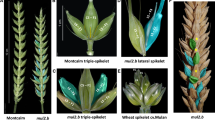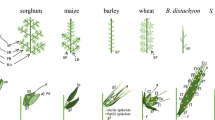Abstract
Almost all wheat species have an unbranched spike. Tetraploid rivet wheat Triticum turgidum L., branched forms of which are widespread and have been known for about 2000 years, is an exception. As for other wheat species, supernumerary spikelet forms are rare, and supernumerary spikelet/branched spike belongs to nonstandard morphotypes. As one of the examples illustrating the law of homologous series in variation, N.I. Vavilov presented the trait “spike branching” peculiar “not only to many wheat and rye species but also to many other genera with spike inflorescence or panicle.” The studies of genetic factors underlying the formation of “supernumerary spikelet/spike branching” trait and the study of peculiarities of the development of inflorescences of nonstandard branched wheat forms made it possible to demonstrate a genetic nature of hereditary variation of this trait. At the same time, the group of supernumerary spikelet/branched-lines is heterogeneous, and different genetic mechanisms can underlie the formation of branched spike. This review presents a retrospective of scientific studies devoted to the creation of supernumerary spikelet wheat forms and to the study of genetics of “supernumerary spikelet/spike branching” trait and demonstrates the results of modern studies of genetic regulation of morphogenesis of cereal inflorescences using supernumerary spikelet lines as genetic models.

Similar content being viewed by others
REFERENCES
Vavilov, N.I., Zakon gomologicheskikh ryadov v nasledstvennoi izmenchivosti (Law of Homological Series in Hereditary Variation), Leningrad: Nauka, 1987.
Dorofeev, V.F., Filatenko, A.A., Migusheva, E.F., et al., Kul’turnaya flora SSSR: pshenitsa (Cultural Flora of the USSR: Wheat), Leningrad.: Kolos, 1979, vol. 1.
Dahlgren, B.E., Wheat, Chicago: Field Museum of Natural History, 1922.
Percival, J., The Wheat Plant, London: Duckworth, 1921.
Dorofeev, V.F., Spontaneous mutations as a factor in the wheat formation, Vestn. S.-kh.Nauki, 1968, vol. 7, pp. 16—26.
Coffman, F.A., Supernumerary spikelets in Mindum wheat, J. Hered., 1924, vol. 5, pp. 187—192.
Goncharov, N.P., Sravnitel’naya genetika pshenits i ikh sorodichei (Comparative Genetics of Wheat and Their Relatives), Novosibirsk: Geo, 2012.
Amagai, Y., Martinek, P., Watanabe, N., et al., Microsatellite mapping of genes for branched spike and soft glumes in Triticum monococcum L., Genet. Resour. Crop Evol., 2014, vol. 61, pp. 465—471. https://doi.org/10.1007/s10722-013-0050-9
Tsitsin, N.V., Branched winter rye, in Otdalennaya gibridizatsiya (Remote Hybridization), Moscow: Sel’khozgiz, 1954, pp. 313—322.
Alieva, A.J. and Aminov, N.K., Influence of D genome of wheat on expression of novel type spike branching in hybrid populations of 171ACS line, Russ. J. Genet., 2013, vol. 49, no. 11, pp. 1119—1126. https://doi.org/10.1134/S1022795413110021
Mel’nik, V.M., Kozlovskaya, V.F., Pastukhov, G.P., et al., Study of allelic relationships in induced spring wheat mutants, Aktual’nye voprosy genetiki i selektsii rastenii (Current Issues of Genetics and Plant Breeding) (Proc. Sib. Region Conf.), Shumnii, V.K. and Kalinina, I.P., Eds., Novosibirsk, 1980.
Mel’nik, V.M. and Pastukhov, G.P., Geneticheskie issledovaniya indutsirovannykh mutantov yarovoi pshenitsy: khimicheskii mutagenez v povyshenii produktivnosti sel’skokhozyaistvennykh rastenii: (Genetic Studies of Induced Mutants of Spring Wheat: Chemical Mutagenesis to Increase the Productivity of Crops), Moscow: Nauka, 1984.
Sharman, B.C., Branched head in wheat and wheat hybrids, Nature, 1944, vol. 153, pp. 497—498.
Swaminathan, M.S., Chopra, V.L., and Sastry, G.R.K., Expression and stability of an induced mutation for ear branching in bread wheat, Curr. Sci., 1966, vol. 35, pp. 91—92.
Koric, S., Branching genes in Triticum aestivum, Proceedings of 4th International Wheat Genetics Symposium, Sears, E.R. and Sears, L.M.S., Eds., Columbia, MO, USA, 1973, pp. 283—288.
Koric, S., Study of branched gene complex of T. aestivum ssp. vulgare and its significance for wheat breeding, J. Sci. Agric. Res., 1980, vol. 142, pp. 271—282.
Li, J., Wang, Q., Wei, H., et al., SSR mapping for locus conferring on the triple spikelet trait of the Tibetan triple-spikelet wheat (Triticum aestivum L. concv. tripletum), Triticeae Genomics Genet., 2011, vol. 2, pp. 1—6. https://doi.org/10.5376/tgg.2011.02.0001
Pennell, A.L. and Halloran, G.M., Inheritance of supernumerary spikelets in wheat, Euphytica, 1983, vol. 32, pp. 767—776.
Klindworth, D.L., Williams, N.D., and Joppa, L.R., Inheritance of supernumerary spikelets in a tetraploid wheat cross, Genome, 1990, vol. 33, pp. 509—514.
Martinek, P., Gene resources with non-standard spike morphology in wheat, in Proceedings of 9th International Wheat Genetics Symposium, Saskatoon, Saskatchewan, Canada, 1998, vol. 2, pp. 286—288.
Martinek, P. and Bednar, J., Changes of spike morphology (multirow spike—MRS, longglumes—LG) in wheat (Triticum aestivum L.) and their importance for breeding, Genetic Collections, Isogenic and Alloplasmic Lines (Proc. Int. Conf. Novosibirsk, Russia), 2001, pp. 192—194.
Sears, E.R., The Aneuploids of Common Wheat, Columbia, MO: Univ. Missouri, 1954, pp. 3—58.
Amagai, Y., Aliyeva, A.J., Aminov, N.Kh., et al., Microsatellite mapping of the genes for sham ramification and extra glume in spikelets of tetraploid wheat, Genet. Resour. Crop Evol., 2014, vol. 61, pp. 491—498. https://doi.org/10.1007/s10722-013-0052-7
Amagai, Y., Aliyeva, A.J., Aminov, N.Kh., et al., The third glume phenotype is associated with rachilla branching in the spikes of tetraploid wheat (Triticum L.), Genet. Resour. Crop Evol., 2017, vol. 64, pp. 835—842. https://doi.org/10.1007/s10722-017-0503-7
Bonnet, O.T., The development of the wheat spike, J. Agr. Res., 1936, vol. 53, pp. 445—451.
Shitsukawa, N., Kinjo, H., Takumi, S., et al., Heterochronic development of the floret meristem determines grain number per spikelet in diploid, tetraploid and hexaploid wheats, Ann. Bot., 2009, vol. 104, pp. 243—251. https://doi.org/10.1093/aob/mcp129
Dobrovolskaya, O.B., Badaeva, E.D., Adonina, I.G., et al., Investigation of morphogenesis of inflorescence and determination of the nature of inheritance of “supernumerary spikelets” trait of bread wheat (Triticum aestivum L.) mutant line, Russ. J. Dev. Biol., 2014, vol. 45, pp. 361—366. https://doi.org/10.1134/S1062360414060034
Dobrovolskaya, O., Pont, C., Sibout, R., et al., FRIZZY PANICLE drives supernumerary spikelets in bread wheat (T. aestivum L.), Plant Physiol., 2015, vol. 167, pp. 189—199. https://doi.org/10.1104/pp.114.250043
Dobrovolskaya, O.B., Amagai, Y., Popova, K.I., et al., Genes WHEAT FRIZZY PANICLE and SHAMRAMIFICATION 2 independently regulate differentiation of floral meristems in wheat, BMC Plant Biol., 2017, vol. 17, suppl. 2, article 252. https://doi.org/10.1186/s12870-017-1191-3
Komatsu, M., Chujo, A., Nagato, Y., et al., FRIZZY PANICLE is required to prevent the formation of axillary meristems and to establish floral meristem identity in rice spikelets, Development, 2003, vol. 130, pp. 3841—3850. https://doi.org/10.1242/dev.00564
Chuck, G., Muszynski, M., Kellogg, E., et al., The control of spikelet meristem identity by the branched silkless1 gene in maize, Science, 2002, vol. 298, pp. 1238—1241. https://doi.org/10.1126/science.1076920
Derbyshire, P. and Byrne, M.E., MORE SPIKELETS1 is required for spikelet fate in the inflorescence of Brachypodium distachyon,Plant Physiol., 2013, vol. 161, pp. 1291—1302. https://doi.org/10.1104/PP.112.212340
Poursarebani, N., Seidensticker, T., Koppolu, R., et al., The genetic basis of composite spike form in barley and “Miracle-Wheat”, Genetics, 2015, vol. 201, pp. 155—165. https://doi.org/10.1534/genetics.115.176628
Boden, S.A., Cavanagh, C., Cullis, B.R., et al., Ppd-1 is a key regulator of inflorescence architecture and paired spikelet development in wheat, Nat. Plants, 2015, vol. 1, article 14016. https://doi.org/10.1038/nplants.2014.16
Peng, Z.S., Yen, C., and Yang, J.L., Chromosomal location of genes for supernumerary spikelet in bread wheat, Euphytica, 1998, vol. 103, pp. 109—114. https://doi.org/10.1023/A:1018323310621
Klindworth, D.L., Williams, N.D., and Joppa, L.R., Inheritance of supernumerary spikelets in a tetraploid wheat cross, Genome, 1990, vol. 33, pp. 509—514. https://doi.org/10.1139/g90-076
Klindworth, D.L., Klindworth, M.M., and Williams, N.D., Telosomic mapping of four genetic markers in durum wheat, J. Hered., 1997, vol. 88, pp. 229—232. https://doi.org/10.1093/oxfordjournals
Laikova, L.I., Arbuzova, V.S., Popova, O.M., et al., Study of spike branching in mutant lines of bread wheat variety Saratov 29, in Aktual’nye zadachi selektsii i semenovodstva sel’skokhozyaistvennykh rastenii na sovremennom etape: doklady i soobshcheniya IX genetiko-selektsionnoi shkoly. (5—9 aprelya 2004 g.) (Relevant Problems of Breeding and Seed Production of Agricultural Crops at the Present Stage: Abstracts and Reports of the IX Genetic-Breeding School (April 5—9, 2004)), Novosibirsk, 2005, pp. 388—393.
Sun, D.F., Inheritance of genes controlling supernumerary spikelet in wheat line 51885, Euphytica, 2009, vol. 167, pp. 173—179. https://doi.org/10.1007/s10681-008-9854-7
Muramatsu, M., A presumed genetic system determining the number of spikelets per rachis node in the tribe Triticeae, Breed. Sci., 2009, vol. 59, pp. 617—620. https://doi.org/10.1270/jsbbs.59.617
Košner, J. and Foltyn, J., Chromozomalní poměry pšenice obecné (Triticum aestivum L.) s větevnatým klasem, Sbor. Ú-VTIZ, Genet. Šlecht., 1989, vol. 25, no. 1, pp. 11—17.
Dobrovol’skaya, O.B., Martinek, P., Adonina, I.G., et al., Effect of rearrangements of homoeologous group 2 chromosomes of bread wheat on spike morphology, Vavilovskii Zh. Genet. Sel., 2014, vol. 18, no. 4/1, pp. 672—680. https://doi.org/10.7868/S0475145014060032
Haque, M.A., Martinek, P., Kobayashi, S., et al., Microsatellite mapping of genes for semi-dwarfism and branched spike in Triticum durum Desf. var. ramosoobscurum Jakubz.“Vetvistokoloskaya,” Genet. Resour. Crop Evol., 2012, vol. 59, pp. 831–837. https://doi.org/10.1007/s10722-011-9722-5
Dobrovolskaya, O., Martinek, P., Voylokov, A.V., et al., Microsatellite mapping of genes that determine supernumerary spikelets in wheat (T. aestivum) and rye (S. cereale), Theor. Appl. Genet., 2009, vol. 119, pp. 867–874. https://doi.org/10.1007/s00122-009-1095-1
Echeverry-Solarte, M., Kumar, A., Kianian, S., et al., Genome-wide genetic dissection of supernumerary spikelet and related traits in common wheat, Plant Genet., 2014, vol. 7, pp. 1–16. https://doi.org/10.3835/plantgenome2014.03.0013
Zhang, R.Q., Hou, F., Chen, J., et al., Agronomic characterization and genetic analysis of the supernumerary spikelet in tetraploid wheat (Triticum turgidum L.), J. Integr. Agr., 2017, vol. 16, pp. 1304–1311. https://doi.org/10.1016/S2095-3119(16)61469-7
Benito, C., Zaragoza, C., Gallego, F.J., et al., A map of rye chromosome 2R using isozyme and morphological markers, Theor. Appl. Genet., 1991, vol. 82, pp. 112–116.
Castiglioni, P., Pozzi, C., Heun, M., et al., An AFLP-based procedure for the efficient mapping of mutations and DNA probes in barley, Genetics, 1998, vol. 149, pp. 2039–2056.
Rossini, L., Vecchietti, A., Nicoloso, L., et al., Candidate genes for barley mutants involved in plant architecture: an in silico approach, Theor. Appl. Genet., 2006, vol. 112, pp. 1073–1085. https://doi.org/10.1007/s00122-006-0209-2
Rao, N.N., Prasad, K., and Kumar, P.R., Distinct regulatory role for RFL, the rice LFY homolog, in determining flowering time and plant architecture, Proc. Natl. Acad. Sci. U.S.A., 2008, vol. 105, pp. 3646–3651. https://doi.org/10.1073/pnas.0709059105
Schnurbush, T., Wheat and barley biology: towards new frontiers, J. Integr. Plant Biol., 2019, vol. 62, pp. 198–203. https://doi.org/10.1111/jipb.12782
Dixon, L.E., Cockram, J.R., Mellers, G., et al., TEOSINTE BRANCHED 1 regulates inflorescence architecture and development in bread wheat (Triticum aestivum), Plant Cell, 2018, vol. 30, no. 3, pp. 563–581. https://doi.org/10.1105/tpc.17.00961
Funding
This work was supported by the Russian Foundation for Basic Research (project no. 18-04-00483-a) and by the budgetary project no. AAAA-A16-116061750188-4.
Author information
Authors and Affiliations
Corresponding author
Ethics declarations
The author declares that she has no conflict of interest. This article does not contain any studies involving animals or human participants performed by the author.
Additional information
Translated by A. Barkhash
Rights and permissions
About this article
Cite this article
Dobrovolskaya, O.B. Supernumerary Spikelet Wheat Forms as Models for Studying Genetic Regulation of Inflorescence Development. Russ J Genet 56, 1298–1307 (2020). https://doi.org/10.1134/S1022795420110034
Received:
Revised:
Accepted:
Published:
Issue Date:
DOI: https://doi.org/10.1134/S1022795420110034




